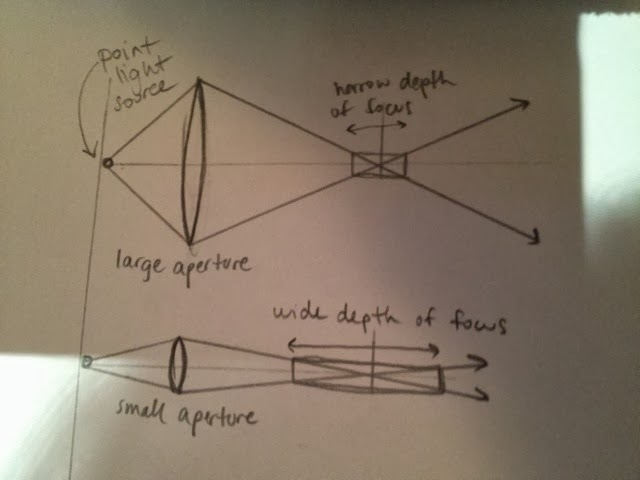Description:
One example of a commonplace instrument with a lens is the camera. This lab explored the use of aperture, the opening that light passes through before producing a real image on the sensor in a camera. Aperture can effect the characteristics of a photograph or image, and the goal of this lab was to investigate what those effects were and how they were related to the size and shape of the aperture.
Purpose:
To predict, observe and discover the relationship between aperture, real image formation and depth of field.
Procedure/ Results:
Part A: The Half Lens
First, we set up the Optics Expansion Kit on the Dynamic System track. We put the light source at 10 cm, the 10 cm convex lens at 30 cm, and the screen at about 50 cm, and then moved it so that an image was visible when the light source was on the "4" setting. We then placed the aperture assembly right behind the lens. We observed that:
4. The image was brighter without the aperture assembly and fainter with it
5. We predicted that the image on the screen would be fainter with the D-shaped aperture.
6. The image was, indeed, fainter with the D-shaped aperture.
7. We predicted that the image would get fainter as the aperture got smaller. The image did, in fact, get fainter. However, it also became sharper. We thought that this might be happening because less light was able to travel through the aperture, but because of the way it bounced off the sides of the aperture, it resulted in a sharper image.
Part B: Aperture and Depth of Field
Then we looked at depth of field.
2. We predicted that a smaller aperture would produce a greater depth of field, like one would see in photography.
We recorded the depth of field at different apertures. Our findings can be seen in the data table below:
Aperture v. Depth of Field Table:
This confirmed our initial prediction that a smaller aperture would produce a greater depth of field.
Visuals:
Note: These photographs were taken of our initial set-up, which was based off of an outdated version of the lab procedure. When we actually did the lab and recorded data points, the components were closer together, but were arranged in the same order.
Analysis / Description of what we learned:
In this lab, we learned about the relationship between aperture and depth of field. We learned that a smaller aperture corresponds with a larger depth of field. We also observed that a "D" shape aperture does not "cut off" half of an image, but simply makes that image fainter. We also learned that when an aperture is smaller, an image becomes fainter but also sharper.
Extensions:
1. "F-stop," also knows as "f-number," controls the amount of light that hits the film or electronic sensor in a camera. It is written as f/d, where f=focal length and d=diameter of the aperture, so a higher f-number actually means a smaller aperture. F-stop is usually measured and labeled by the number of d. "d" usually increases by a factor of the square root of two, so common f-stop numbers would be: f/2, f/2.8, f/4, f/5.6, f/8, f/11, f/16. Each f-stop admits half the amount of light as the previous f-stop.
There are trade offs that a photographer must consider when choosing a f-stop. The smaller the aperture (and greater the f-stop), the less light a camera lets in. Therefore it would need a slower shutter speed, which can increase the blurriness in a picture. However, a small aperture creates a photograph with a large depth of field. This is a good method to use when it is light outside, or you if are photographing a landscape using a tripod. A larger aperture would allow for a smaller depth of field, but a shorter shutter speed. This method is best used in low lighting or for sports photography.
(http://hyperphysics.phy-astr.gsu.edu/hbase/geoopt/stop.html#c2)
2. The depth of field increases as the aperture decreases because the size of the aperture affects what light is in focus. This diagram shows how a larger or smaller aperture affects how the light hits a sensor, and therefor how narrow or deep the focus is.





